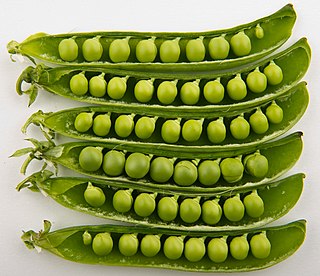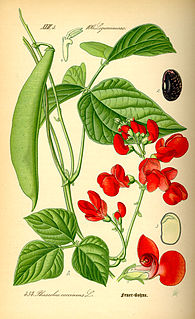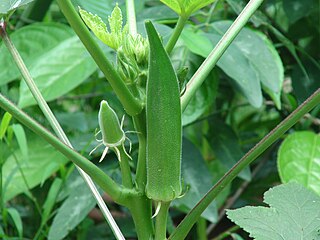
The cocoa bean or simply cocoa, which is also called the cacao bean or cacao , is the dried and fully fermented seed of Theobroma cacao, from which cocoa solids and cocoa butter can be extracted. Cocoa beans are the basis of chocolate, and Mesoamerican foods including tejate, an indigenous Mexican drink that also includes maize.

The pea is most commonly the small spherical seed or the seed-pod of the pod fruit Pisum sativum. Each pod contains several peas, which can be green or yellow. Botanically, pea pods are fruit, since they contain seeds and develop from the ovary of a (pea) flower. The name is also used to describe other edible seeds from the Fabaceae such as the pigeon pea, the cowpea, and the seeds from several species of Lathyrus.

The radish is an edible root vegetable of the family Brassicaceae that was domesticated in Asia prior to Roman times.

Phaseolus coccineus, known as runner bean, scarlet runner bean, or multiflora bean, is a plant in the legume family, Fabaceae. Another common name is butter bean, which, however, can also refer to the lima bean, a different species.

Phaseolus vulgaris, also known as the common bean and French bean, is a herbaceous annual plant grown worldwide for its edible dry seeds or unripe fruit. The main categories of common beans, on the basis of use, are dry beans, snap beans and shell (shelled) beans. Its leaf is also occasionally used as a vegetable and the straw as fodder. Its botanical classification, along with other Phaseolus species, is as a member of the legume family Fabaceae. Like most members of this family, common beans acquire the nitrogen they require through an association with rhizobia, which are nitrogen-fixing bacteria.

Osteospermum, is a genus of flowering plants belonging to the Calenduleae, one of the smaller tribes of the sunflower/daisy family Asteraceae. They are known as the daisybushes or African daisies.

Jacaranda mimosifolia is a sub-tropical tree native to south-central South America that has been widely planted elsewhere because of its attractive and long-lasting violet-colored flowers. It is also known as the jacaranda, blue jacaranda, black poui, or fern tree. Older sources call it J. acutifolia, but it is nowadays more usually classified as J. mimosifolia. In scientific usage, the name "jacaranda" refers to the genus Jacaranda, which has many other members, but in horticultural and everyday usage, it nearly always means the blue jacaranda.

Nigella is a genus of 18 species of annual plants in the family Ranunculaceae, native to Southern Europe, North Africa, South Asia, Southwest Asia and Middle East. Common names applied to members of this genus are nigella, devil-in-a-bush or love-in-a-mist.

Terminalia is a genus of large trees of the flowering plant family Combretaceae, comprising nearly 300 species distributed in tropical regions of the world. The genus name derives from the Latin word terminus, referring to the fact that the leaves appear at the very tips of the shoots.

Okra or Okro, Abelmoschus esculentus, known in many English-speaking countries as ladies' fingers or ochro, is a flowering plant in the mallow family. It is valued for its edible green seed pods. It is a good source of minerals, vitamins, antioxidants, and fiber. The geographical origin of okra is disputed, with supporters of West African, Ethiopian, and South Asian origins. The plant is cultivated in tropical, subtropical and warm temperate regions around the world and is a notable part of the cuisine of the Southern United States.

Wisteria floribunda, common name Japanese wisteria, is a species of flowering plant in the family Fabaceae, native to Japan. Growing to 9 m (30 ft), it is a woody, deciduous twining climber. It was first brought from Japan to the United States in the 1830s. Since then, it has become one of the most highly romanticized flowering garden plants. It is also a common subject for bonsai, along with Wisteria sinensis.

Grevillea robusta, commonly known as the southern silky oak, silk oak or silky oak, silver oak or Australian silver oak, is a flowering plant in the family Proteaceae. It is a tree, the largest species in its genus but is not closely related to the true oaks, Quercus. It is a native of eastern coastal Australia, growing in riverine, subtropical and dry rainforest environments.

A popular house plant, Streptocarpus, is an Afrotropical genus of flowering plants in the family Gesneriaceae. The genus is native to Afromontane biotopes from central, eastern and southern Africa, including Madagascar and the Comoro Islands. The flowers are five-petalled, salverform tubes, almost orchid-like in appearance, and hover or arch over the plant, while the pointed, elongate fruit is of a helical form similar to that of the "tusk" of a narwhal. In the wild, species can be found growing on shaded rocky hillsides or cliffs, on the ground, in rock crevices, and almost anywhere the seed can germinate and grow. For the home, there are now many hybrids of various colours and forms available.

Peri-peri is a cultivar of Capsicum frutescens from the malagueta pepper. It was originally produced by Portuguese explorers in Portugal's former Southern African territories and then spread to other Portuguese domains.

Terminalia macroptera is a species of flowering plant in the Combretaceae known by the Hausa common name kwandari. It is native to Africa, where it can be found in Benin, Burkina Faso, Ghana, Senegal, Sudan, Uganda, and Nigeria.
Terminalia microcarpa is a tree species in the family Combretaceae. It occurs in Indonesia, Malaysia, the Philippines, Papua New Guinea and Australia.
Terminalia petiolaris, commonly known as blackberry tree or billygoat plum, or marool in the local Bardi language, is a species of plant in the Combretaceae family. It is endemic to the coast of the Kimberley region of northern Western Australia.

Terminalia hadleyana is a tree of the family Combretaceae native to northern Australia.
Terminalia polycarpa is a small African tree in the family Combretaceae. It is native to Ethiopia, Kenya, and Somalia. The flowers are white or cream in hairy spikes up to 11 cm (4.3 in) long.

















